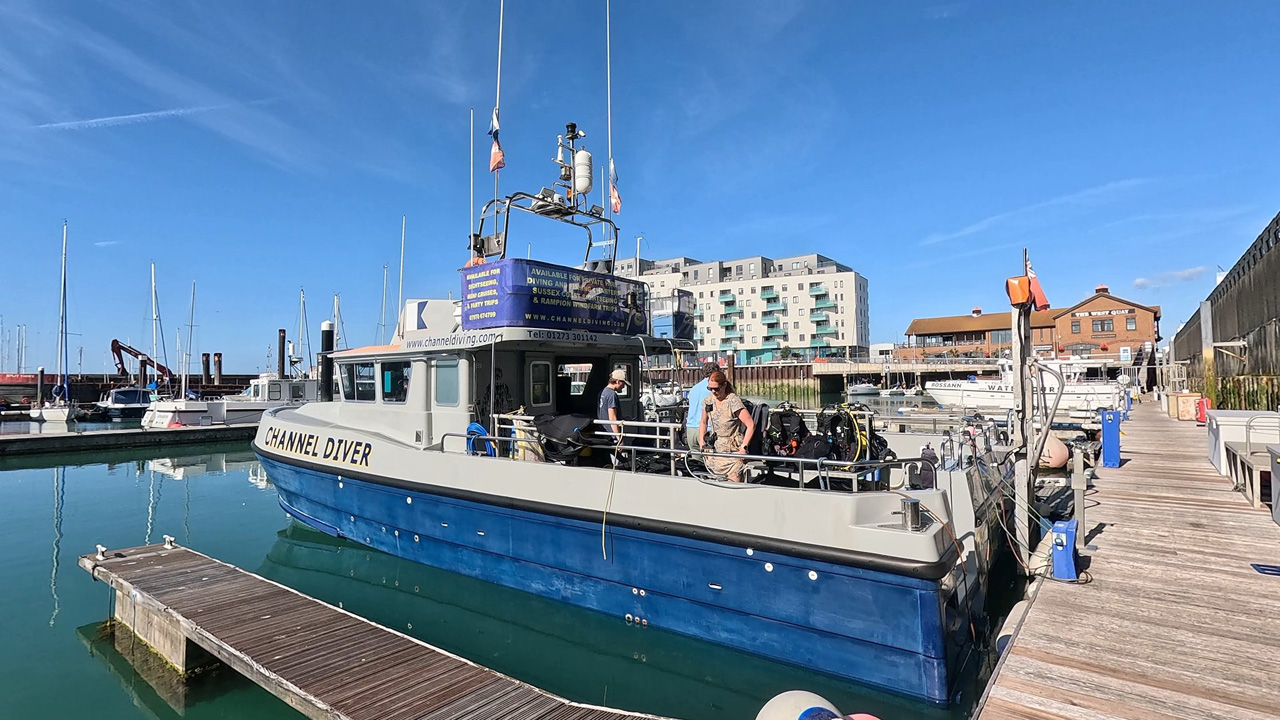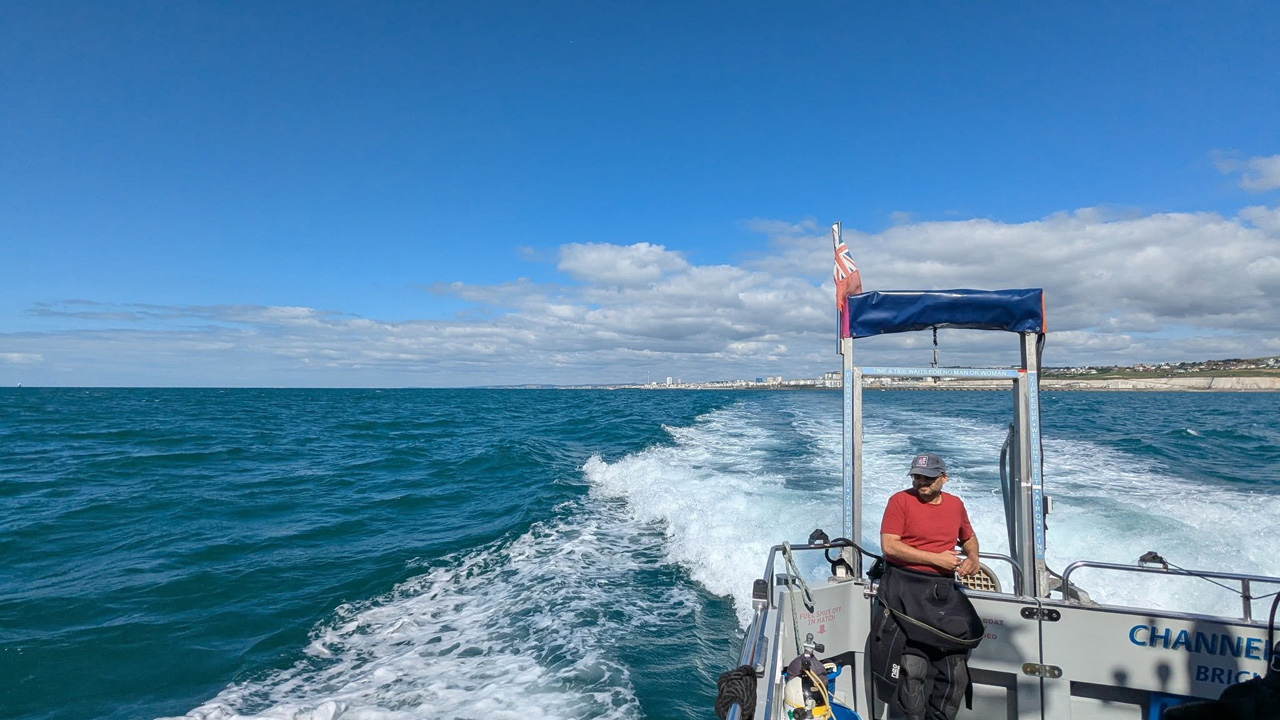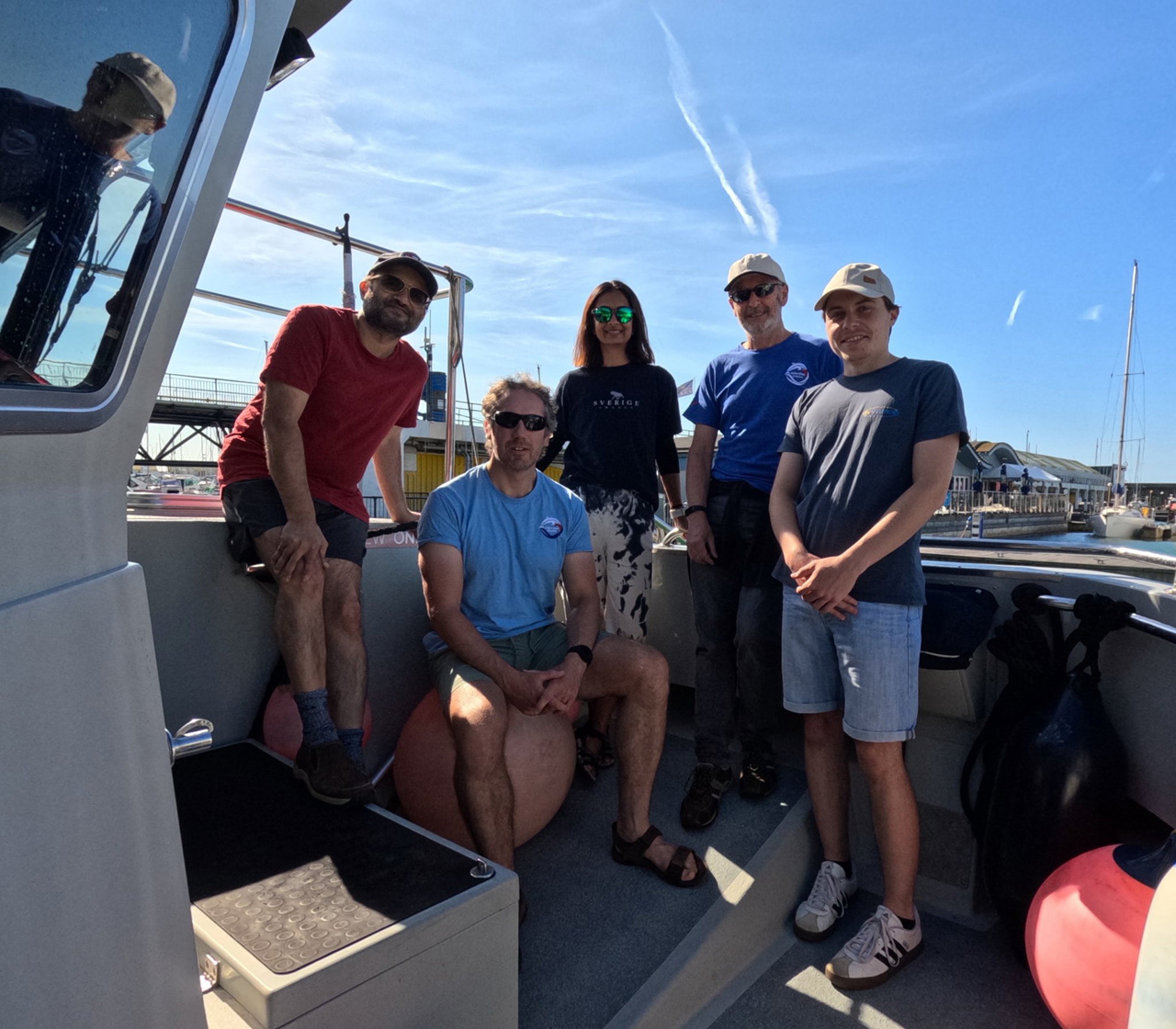Diving - My Continuing Adventures underwater
Club diving from Brighton
After the trip to Scotland, we were back on the south coast, diving with Channel Diver out of Brighton.
We elected to dive on the City of Brisbane wreck on this visit.

Loading Channel Diver - Ria's photo
The forecast leading up to the day was good and 6 of us, plus a couple of guests (David and Gill, parents of our club member, Fran) and a trio from another club arrived (one of our members had to pull out at the last moment) arrived at a very civilised 9AM or so and loaded Channel Diver, Steve's very roomy boat.
We set off after Steve's briefing under sunny skies and a gentle sea, if not totally becalmed.
We kitted up as we travelled and it took us around 40 minutes to reach the site of the City of Brisbane.

A great day for diving - At first, at least.
I had dived the wreck before, way back in 2017 on a hectic weekend when Julian and Paul carried out their Advanced Diver expedition dives, but I couldn't remember it.
My logbook records "A large wreck with shot in the middle. Loads of fish and Lobsters".
The Brisbane is best known for having a significant bow struture still intact, rising some 6M off the seabed.
Steve had put the shot in just aft of the bow, so Saby, my buddy for the dive, and I swam forward and quickly found the wall of the starboard side of the bow alongside us.
We swam around the bow, near the seabed and then rose up onto the top of it.
We explored the bow a little and then set off down the length of the ship. The viz was quite full of particles, so not more than 3M or so in most places, but with our torches there was plenty to see, both life and wreck.
My intention was to reach the stern and look for the gun that's supposedly there, but I'm not sure if we ever quite got to the stern and we certainly didn't see anything that looked like a gun before we were running low on gas, so I put up my DSMB and we ascended, completed a safety stop and rejoined the boat.
Some video from the dive on the City of Brisbane
It was notably choppier on surfacing than it had been when we went in and it was to continue getting rougher (although I've dived in a lot worse) as the wind picked up.
Caroline, Steve's wife and deckhand for the day, told us he was going to find a more sheltered spot for us to switch cylinders, but diving along this stretch of coast offers very little in the way of shelter, so it was still a bit choppy as we switched to our second tanks for the second dive.
Tom came over and send he was feeling to ill to do the second dive and Saby and Ria both looked a little the worse for wear, but elected to dive. Ria said she'd far rather dive than spend another 45 minutes on the boat!
The second dive was probably my least favourite dive on the south coast, Kings West Ledges.
The ledges are 1 to 1.5 metre high rock wall along which you'll spot various common sealife, if you're lucky.
The dive didn't start too well as, diving as a 3, with Seadhna, Tom's buddy, we got separated from Saby. We assumed he was just taking a while to descend, but when there was no sign of him after a few minutes, we surfaced and Steve said he was underwater, swimming away from us.
We knew we wouldn't find him, so we descended, hoping he'd surface safely. It turned out a few moments after we descended, he put up his DSMB and surfaced, returning to the boat when told we'd been up and descended again.
Some might say we should have abandoned our dive, but the skipper could see his bubbles and there was nothing we could do to improve things, anyway.
To be fair, this particular dive was far from the worst I've done here (it's the go-to site for a second dive from Brighton), with plenty of Congers hiding in the rocks, including one large one that I lured out with the offer of a finger.
Sadly, though, I'd left my camera running between dives and had a lot of footage of my BCD and a flat battery when I came to film the first of the Congers we came across.

(most of)the Aldershot Dolphins contingency - L to R: Saby, Seadhna, Ria, Me, Tom (Andrew was off eating breakfast still!) - Ria's photo
We were back in Brighton Marina at 3:30 sharp, exactly the time Steve had predicted, and managed to get unloaded and our gear packed in the car and we had a untroubled drive home, reaching Fleet by 6, after dropping Ria home, in Guildford.
While the conditions weren't great and some of the others suffered with sea-sickness, I had thoroughly enjoyed myself!
Inland Diving with the club
The following weekend we had a club RHIB dive planned, but F5, gusting F6, winds put paid to that plan, so Phil and I popped down to Wraysbury for a quick dip.
It was unusually overcast, but the water was a toasty 22C down to about 8M, so it was very pleasant, especially on the first dive, when we managed to be one of the first divers in and enjoyed surprisingly good vis for Wraysbury on a busy summer weekend.
Phil took us around many of the sites over 45 minutes, including the lifeboat, airplane and the corrugated tubes at the south end and got us back to our entry point in the car park, despite a constantly fogging mask, and my Hunter drysuit only very slightly leaked through the wrist seals (My Seaskin suit still wasn't back from having its zip replaced).
After the obligatory bacon sandwich and a cup of tea over an hour's surface interval (probably not that important when your max depth was above 10M) we set off towards the cave complex.
As a test I tried folding the very long latex wrist seals in my suit in, the way you would with neoprene, as I know some people do this, although it's not how they're designed to work.
The left wrist didn't leak, but almost as soon as I left the surface I could feel water going in the right, so I surfaced and flattened them out, which reduced the flow to seemingly nothing, although the forearms of my undersuit were again damp after the dive.
We then dropped down and headed towards the bus, but the vis was under a metre immediately.
From memory we found the bus and then tried to head towards the cave, but the weeds were very extensive and the vis still near zero, so I couldn't find the edge of the drop-off that we usually navigate to reach them.
Eventually, we did come across a drop off, but it led to the Portakabin and the boat above it.
We swam around a bit more, but after seeing some more boats and the Die Hard Taxi (now nearly completely corroded away with the roof collapsed), we found ourselves back at the boat on the drop off, so I returned back along the drop off and, passing a few other sites, we eventually found ourselves at the Milk Float platform (It's a platform built on an old Milk Float!).
The vis got better after that and we found ourselves at the lifeboat again and turned back across the lake, reaching the London Cab.
Here the vis deterioted dramatically again, so we ascended after a 48 minute dive and had a short surface swim back to the pier in the car park.
We'd obviously had the best of the visibility, so we packed and headed home after that dive, but it had been enjoyable to be in the warm water.
A couple of weeks later, I'd got my Seaskin drysuit back (with a new zip and neck seal) and joined a group of other club divers at Vobster to try it out.
I dived with Fran, who I hadn't dived with since I did some of her early Ocean Diver training.
She is now a Sports Diver and was keen to progress to deeper dives, going to 25M as the first step.
Vobster was very busy and there was a greenish hue to the water looking from the side, the water level was really low as well.
Fran and I headed to the drop in above the plane, but initially she couldn't descend, so I climbed out of the water and went to see if we had some more weights. As I couldn't find any, I bought a couple of kilos for her in the shop, returned and she was able to descend without problem with the extra work.
Fran struggled a bit with her ears on the descent, so it took a few minutes to get down.
We dropped down and found the plane, but the vis was quite cloudy.
We swam from the plane over to the crushing works and dropped down the outside wall in search of the Sea King helicopter.
Fran was taking it slowly, clearing her ears and I spotted the top of the helicopter, so swam over to it to wait for her.
The vis around the helicopter was reasonably good, although quite short, so we swam around the front and then through the fuselage, before heading back up the road, to the wheelhouse and the Jacquin II wreck.
From there, as we'd not quite reached 25M (24.1) on the helicopter, we dropped into the pit, visiting the Vauxhall there, which gave us 25.1M.
We swam back up and joined a long queue at the usual safety stop point above the end of the tunnel, but there were a lot of people there and I suspected the exit would be both crowded and slippery, so once our safety stop was completed, we swam over to the ladder in front of the shop and exited there.
Water in the first 10M or so was a very comfortable 18-20C, but dropping below that the temperature dropped quickly and was down to a very chilly feeling 8C at the helicopter.
For the second dive of the day, we decided to go down to the remains of the caravan and the jesters.
We jumped in in front of the shop and then took a little while descending as Fran let her ears adapt.
We swam over the pit, to the wheelhouse and from there we found the line that led from there down to the caravan, which is now just a pile of wreckage.
The vis down at 24M was pretty decent, so it was easy enough to find the line to the small yacht, although here it was a consistently cold 8C.
We swam off the prow of the yacht, swimming blind for a few minutes, before the wheelhouse loomed up.
From there we swam to a couple of the jesters and then up the wall to the top of the crushing works.
Vis towards the plane was terrible, lots of trainees stirring up the silt, so I turned back to the crushing works and we dropped down the inside and then out through the small hole at the bottom.
I checked Fran's air and as she still had a fair amount, we turned right and had another tour around the Sea King, before swimming back up to the bottom of the tunnel.
A couple of divers were coming down, so we waited for them to exit and then went in. I turned on my torch, but it only stayed on for about 30 seconds, before it failed because of a low battery, but by then we could see light filtering in through the exit at the top.
Again, we safety stopped in the usual place and then swam over to exit via the ladder in front of the shop.
We'd had a couple of decent dives, considering the crowds and the poor visibility in places.


